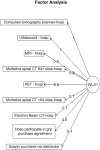Development of a Hospital Medical Surge Preparedness Index using a national hospital survey
- PMID: 32435150
- PMCID: PMC7222860
- DOI: 10.1007/s10742-020-00208-6
Development of a Hospital Medical Surge Preparedness Index using a national hospital survey
Abstract
To generate a Hospital Medical Surge Preparedness Index that can be used to evaluate hospitals across the United States in regard to their capacity to handle patient surges during mass casualty events. Data from the American Hospital Association's annual survey, conducted from 2005 to 2014. Our sample comprised 6239 hospitals across all 50 states, with an annual average of 5769 admissions. An extensive review of the American Hospital Association survey was conducted and relevant variables applicable to hospital inpatient services were extracted. Subject matter experts then categorized these items according to the following subdomains of the "Science of Surge" construct: staff, supplies, space, and system. The variables within these categories were then analyzed through exploratory and confirmatory factor analyses, concluding with the evaluation of internal reliability. Based on the combined results, we generated individual (by hospital) scores for each of the four metrics and an overall score. The exploratory factor analysis indicated a clustering of variables consistent with the "Science of Surge" subdomains, and this finding was in agreement with the statistics generated through the confirmatory factor analysis. We also found high internal reliability coefficients, with Cronbach's alpha values for all constructs exceeding 0.9. A novel Hospital Medical Surge Preparedness Index linked to hospital metrics has been developed to assess a health care facility's capacity to manage patients from mass casualty events. This index could be used by hospitals and emergency management planners to assess a facility's readiness to provide care during disasters.
Keywords: Factor analyses; Health care utilization; Mass casualty events; Medical surge; Preparedness index.
© Springer Science+Business Media, LLC, part of Springer Nature 2020.
Conflict of interest statement
Conflict of interestDavid Marcozzi declares that he has no conflict of interest. Ricardo Pietrobon declares that he has no conflict of interest. James V. Lawler declares that he has no conflict of interest. Michael T. French declares that he has no conflict of interest. Carter Mecher declares that he has no conflict of interest. John Peffer declares that he has no conflict of interest. Nicole E. Baehr declares that she has no conflict of interest. Brian J. Browne declares that he has no conflict of interest.
Figures
References
-
- Agency for Healthcare Research and Quality: Types of Quality Measures. July 2011. https://www.ahrq.gov/professionals/quality-patient-safety/talkingquality.... Accessed on 20 Nov 2018
-
- American College of Emergency Physicians Health care system surge capacity recognition, preparedness, and response: policy statement. Ann. Emerg. Med. 2012;59:240–241. - PubMed
-
- American Hospital Association: Hospital Emergency Preparedness and Response. April 15, 2014. www.aha.org/content/14/ip-hospemerprepared.pdf. Accessed on 21 Nov 2017
-
- American Hospital Association: Hospital Database. https://www.ahadataviewer.com/about/hospital-database/. Accessed 8 March 2018
LinkOut - more resources
Full Text Sources


